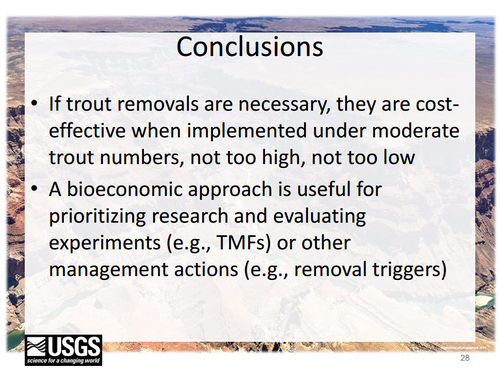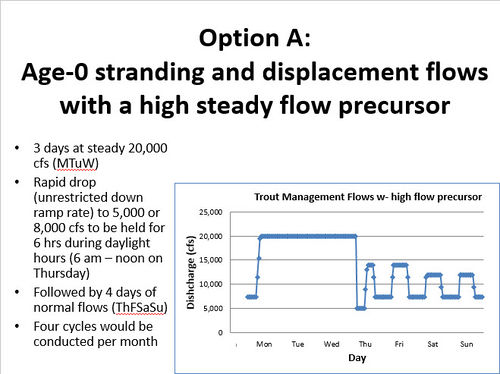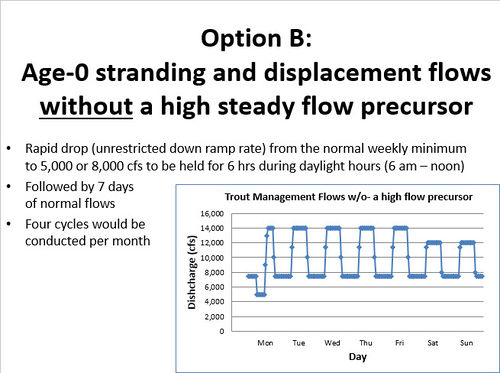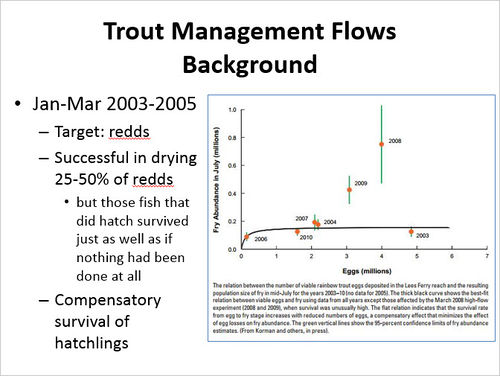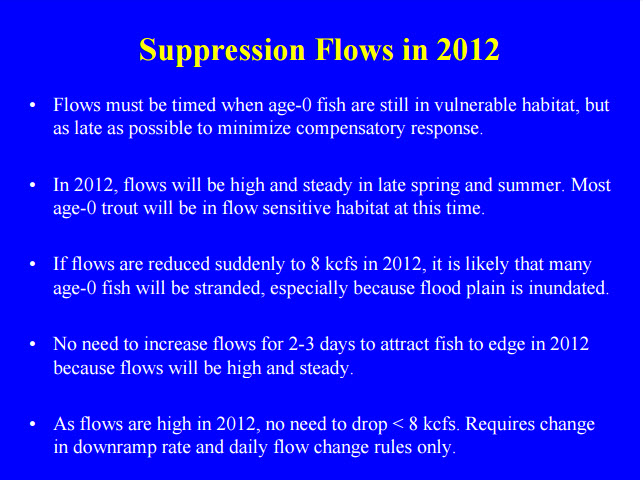Difference between revisions of "Trout Management Flows"
Cellsworth (Talk | contribs) |
Cellsworth (Talk | contribs) |
||
| Line 73: | Line 73: | ||
|- | |- | ||
| − | ! <h2 style="margin:0; background:#cedff2; font-size:120%; font-weight:bold; border:1px solid #a3b0bf; text-align:left; color:#000; padding:0.2em 0.4em;"> | + | ! <h2 style="margin:0; background:#cedff2; font-size:120%; font-weight:bold; border:1px solid #a3b0bf; text-align:left; color:#000; padding:0.2em 0.4em;"> '''Descriptions of Trout Management Flows''' </h2> |
|- | |- | ||
|style="color:#000;"| | |style="color:#000;"| | ||
| − | + | ==[https://www.fws.gov/southwest/es/arizona/Documents/Biol_Opin/120059_LTEMP%20BiOp_11-25-16.pdf LTEMP Biological Assessment, pages 30-41 ]== | |
| + | Experimental Trout Management Flows (TMFs) could be used to control annual | ||
rainbow trout production in the Glen Canyon reach for the purposes of managing | rainbow trout production in the Glen Canyon reach for the purposes of managing | ||
the rainbow trout fishery and for limiting emigration to Marble Canyon and the | the rainbow trout fishery and for limiting emigration to Marble Canyon and the | ||
Little Colorado River reach. TMFs would be tested early in the experimental | Little Colorado River reach. TMFs would be tested early in the experimental | ||
| − | period, preferably in the first 5 years. Under the LTEMP EIS, TMFs could occur from May to August. | + | period, preferably in the first 5 years. Under the LTEMP EIS, TMFs could occur from May to August. |
| + | |||
| + | ==LTEMP FEIS Chapter 2, pages 39-40== | ||
| + | TMFs are a special type of fluctuating flow designed to reduce the recruitment of trout by | ||
| + | disadvantaging YOY trout (Figure 2-15). TMFs have been proposed and developed on the basis | ||
| + | of research described in Korman et al. (2005). The underlying premise of TMFs is based on | ||
| + | observations that YOY trout tend to occupy near-shore shallow-water habitats to avoid predation | ||
| + | by larger fish. TMFs feature repeated fluctuation cycles that consist of relatively high flows | ||
| + | (e.g., 20,000 cfs) sustained for a period of time (potentially ranging from 2 days to 1 week) | ||
| + | followed by a rapid drop to a very low flow (e.g., 5,000 cfs to 8,000 cfs).4 This low flow would | ||
| + | be maintained for a period of less than a day (e.g., 12 hr) to prevent adverse effects on the food | ||
| + | base. Low flows would be timed to start in the morning, after sunrise, to expose stranded fish to | ||
| + | direct sunlight and heat. Up-ramp rates to the TMF would be the same as the limit for this | ||
| + | alternative overall (i.e., 4,000 cfs/hr). The down-ramp from peak to base would be over a single | ||
| + | hour (e.g., 15,000 cfs/hr for a drop from 20,000 cfs to 5,000 cfs). In a TMF flow cycle, YOY | ||
| + | trout are expected to occupy near-shore habitat when flows are highest, and would be stranded | ||
| + | by the sudden drop to low flow. Because older age classes of trout tend to occupy deeper habitats | ||
| + | toward the middle of the river channel, they are less susceptible to stranding and are less likely to | ||
| + | be directly affected by TMFs. TMFs would be used to control trout recruitment in the Glen | ||
| + | Canyon reach to manage the rainbow trout fishery, and to limit emigration of juvenile trout to | ||
| + | downstream reaches, particularly to habitat occupied by humpback chub near the confluence | ||
| + | with the Little Colorado River. Triggers for implementation of TMFs would be determined in | ||
| + | consultation with the AZGFD. | ||
| + | |||
| + | It should be noted that several Tribes have expressed concerns about TMFs as a taking of | ||
| + | life within the canyon without a beneficial use. The Pueblo of Zuni has expressed concern that | ||
| + | the taking of life by trout stranding has an adverse effect on the Zuni value system. The jointlead | ||
| + | agencies will continue to work with the Tribes regarding options for trout management. | ||
| + | |||
| + | TMFs may be tested under this alternative early in the LTEMP period, even if not | ||
| + | triggered by high trout recruitment. The intent of these early tests would be to determine the | ||
| + | effectiveness of TMFs in reducing trout recruitment and the emigration of young trout to Marble | ||
| + | Canyon and the Little Colorado River reach. The condition of the trout fishery, as determined in | ||
| + | consultation with AZGFD, and potential impacts on other important resources would be | ||
| + | considered prior to implementing TMFs. If TMFs are determined to be effective for these goals | ||
| + | while minimizing impacts on other resources, they may be deployed on a regular or triggered | ||
| + | basis. TMFs would be tested two to three times in the early part of the LTEMP period while | ||
| + | attempting to minimize confounding effects with other experimental treatments. Tests would | ||
| + | start with a conservative application of two cycles in June and July (Figure 2-15), but could be | ||
| + | increased based on experimental testing to as many as three cycles per month for 3 months (May, | ||
| + | June, and July). | ||
|- | |- | ||
Revision as of 16:03, 19 January 2018
|
|
The purpose of implementing Trout Management Flows (TMFs) is to evaluate methods for using releases from Glen Canyon Dam to reduce the production of large numbers of age-0 rainbow trout in order to improve the quality of the Lees Ferry trout fishery and conserve the endangered humpback chub and other native fishes in Grand Canyon. Three objectives were identified for Trout Management Flows:
TMFs could occur from May to August. |
| Rainbow Trout | Brown Trout |
|---|
|
|

